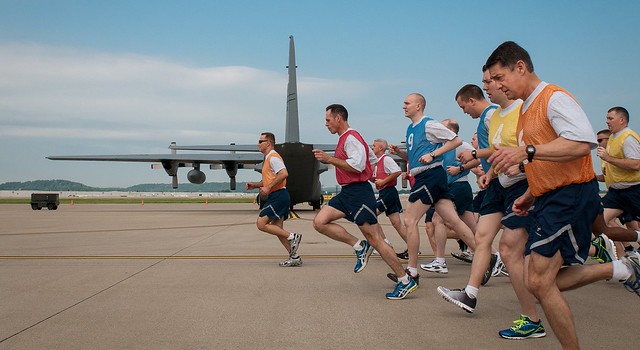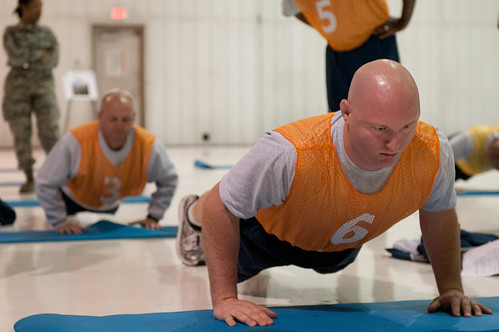Story by Senior Airman Vicky Spesard, 123rd Airlift Wing Public Affairs
[caption id="" align="aligncenter" width="576"]

Members of the 123rd Airlift Wing conduct a mass physical fitness test by running on the flight line of the Kentucky Air National Guard Base in Louisville, Ky., on May 19, 2013. The mass testing is designed to improve efficiency while giving Airmen the edge to succeed. (U.S. Air National Guard photo by Airman Joshua Horton)
KENTUCKY AIR NATIONAL GUARD BASE, LOUISVILLE, Ky. — More than 250 members of the 123rd Airlift Wing took their annual fitness tests here April 28 using a new approach designed to improve efficiency while giving Airmen the edge to succeed.
The program, which was three months in the planning, incorporated a seven-stage process that allowed multiple large groups to complete the test in 30 minute blocks, according to Capt. Tiffany Campbell, wing fitness coordinator. Previous tests were held with groups as small as two, making administration more difficult.
“The format that we used is a huge benefit to our wing,” Campbell said. “It helped us bring many non-current fitness members up to a current status, which improves our overall readiness and helps unit commanders keep all of their members on a regular testing cycle.”
[caption id="" align="alignleft" width="350"]

Staff Sgt. Brandon Curry, a firefighter from the 123rd Civil Engineer Squadron, participates in a mass physical fitness test at the Kentucky Air National Guard Base in Louisville, Ky., on April 27, 2013. The mass testing is designed to improve efficiency while giving Airmen the edge to succeed. (U.S. Air National Guard photo by Airman Joshua Horton)
Stage one of the “mass testing” event was a basic check-in where participants were given a score chart and a colored jersey that coincided with a specific testing coordinator who accompanied the member through the testing process. Stage two was the waist measurement.
Stages three and four consisted of pushups and sit-ups in the Fuel Cell Hangar. Mats were provided for comfort, and music played in the background.
The fifth stage was a 1 ½-mile run that took place on the flight line, providing runners with a flat surface and minimal turns to boost running performance.
Stage six returned participants to the hangar, where their final scores were tallied. Airmen with passing scores were dismissed, while Airmen who failed to meet standards proceeded to stage seven, where they were enrolled in a fitness-improvement program.
Each Airman was assigned a specific time to check in, ensuring that all members would test with Airmen from their own units, Campbell said. In total, six chalks lined up for the test.
“The new format is a great improvement,” Master Sgt. Collin King said after completing his test. “It was a more relaxed environment, and there was more comraderie taking the test with people you know, versus taking the test with one or two people you don’t know.”
Under the previous format, wing members were given numerous opportunities to test throughout the year, often in small groups of just two or three people and with members from different units intermingled together. Pushups and sit-ups were conducted in whatever space was available at the time, and the run took place over an uneven road that threaded past parking lots and active vehicle traffic.
“One of the goals of the new format was to give our members the advantage when taking this test,” Campbell said. “They had the flat surface, which allowed them to have a better run. There were people out there cheering on the testers. The morale overall was huge.
“We had so many volunteers who came out to help with the event,” she continued. “Every little effort that went into it showed. We couldn’t have had the success we did without them.”